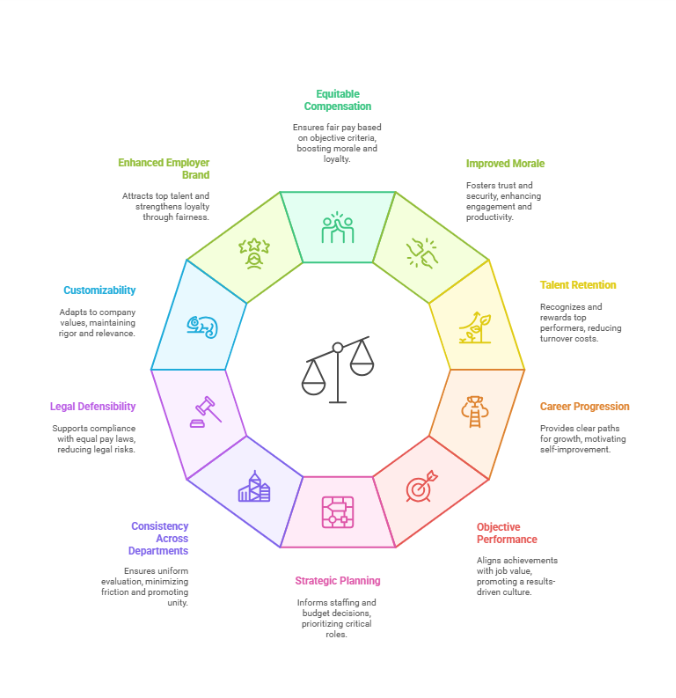Unpacking the Factor Evaluation System: A Strategic Approach to Fair Compensation

 26 June,2025
Share
26 June,2025
Share
In today’s competitive business environment, developing a structured and equitable compensation system is crucial to attracting and retaining talent. The factor evaluation system provides a comprehensive framework for assessing job roles based on various compensable factors like skill, responsibility, effort, and working conditions. Unlike arbitrary pay scales or informal assessments, this method ensures objectivity, fairness, and alignment with organizational goals. By breaking down job roles into measurable elements, organizations can make informed decisions about pay structures, promotions, and resource allocation. This article explores the core concepts, benefits, challenges, implementation strategies, and how Neuronimbus can support your evaluation process.
Core Concepts of the Factor Evaluation System
1. Compensable Factors
Compensable factors form the backbone of the factor evaluation system. These are job elements that an organization values and is willing to pay for, including skill level, responsibility, mental and physical effort, and working conditions. Each factor captures a different dimension of work and helps quantify job value. By clearly defining these elements, organizations can assess jobs consistently and develop pay structures that reflect real job demands, ensuring fairness and alignment with business priorities.
2. Benchmark Jobs
Benchmark jobs are roles within the organization that are well-understood, stable, and represent various levels and functions. These serve as a standard for evaluating other roles. By analyzing these positions first, companies establish a consistent frame of reference. This practice simplifies evaluation across departments and levels, creating a foundation for comparing and pricing all other jobs. Benchmark jobs are typically chosen for their clarity in duties and industry comparability, enabling accurate compensation alignment both internally and externally.
3. Ranking by Factor
Instead of evaluating jobs as a whole, the factor evaluation system ranks each job separately for each compensable factor. For example, a position might be highly ranked for skill but lower for physical effort. This granularity allows for a nuanced view of each job’s contribution and demands. It also minimizes bias by focusing on discrete aspects of work. Ranking jobs independently by factor ensures more equitable and objective assessments, providing a detailed understanding of job complexity.
4. Monetary Value Assignment
After ranking jobs by each factor, monetary values are assigned to the levels of those factors. This step translates qualitative differences into quantifiable terms, forming the basis for a structured pay system. For example, a higher skill ranking could be worth more money, making it clear why one job pays more than another. This financial mapping of job factors helps create transparent and logical compensation models that resonate with both management and staff.
5. Job Comparison and Consistency
Once benchmark jobs are monetized, other jobs are evaluated against them using the same factor scale. This promotes consistency and objectivity across the organization. Jobs with similar total factor values are grouped into pay grades, ensuring fairness. This comparison model prevents overvaluation or undervaluation of roles and keeps the pay structure logically coherent. It also simplifies decisions on promotions, lateral moves, and reclassification by providing clear evaluation criteria.
6. Strategic Alignment and Review
The factor evaluation system isn’t static. It is designed to evolve with the business. Organizations can assign different weights to each factor depending on their strategic goals—such as valuing innovation over routine labor. Additionally, regular reviews ensure that job roles, which may change due to technology or market shifts, are reassessed for accuracy. This adaptability helps maintain internal equity while staying competitive in external markets.
Ready to Build a Smarter Compensation Framework?
Let Neuronimbus help you implement a customized, scalable factor evaluation system that drives fairness and performance.
Talk to Our Experts
Benefits of Implementing a Factor Evaluation System

1. Equitable Compensation Structure
Roles are assessed against consistent and objective criteria, which helps eliminate pay disparities. This creates a workplace environment where compensation is transparent, fair, and reflective of each role’s contribution. As a result, employees feel recognized and valued, which boosts morale and organizational loyalty. It also provides a defense against potential discrimination claims, as each salary decision is backed by a documented evaluation process.
2.Improved Employee Morale
When employees believe that compensation is based on a fair and structured system, it fosters a sense of trust in leadership. Knowing that raises and bonuses aren’t arbitrarily decided helps people feel more secure in their positions. This emotional security translates into stronger workplace engagement and increased productivity, as employees can focus more on their work than worrying about unfair treatment.
3.Enhanced Talent Retention
A well-implemented factor evaluation system ensures top performers are adequately recognized and compensated. When high-performing employees see a clear correlation between their contributions and rewards, they are less likely to explore external opportunities. Retention also saves on recruitment and training costs, maintaining stability and preserving institutional knowledge within the organization.
4.Clear Career Progression
The system outlines exactly what competencies and responsibilities are associated with higher-paying roles. This gives employees a roadmap for professional growth. Instead of guessing what’s needed for a promotion, they can work intentionally towards defined milestones. Such clarity increases motivation and leads to a workforce more committed to self-improvement and internal mobility.
5.Objective Performance Management
Because the factor evaluation system uses measurable and consistent criteria, it complements performance reviews and appraisals. Managers can align individual achievements with the value assigned to job factors, making promotions and bonuses more defensible. This approach reduces favoritism and creates a results-driven culture where recognition is earned.
6.Supports Strategic Planning
Understanding the value of each role helps leadership make informed decisions about staffing and budget allocations. Roles that are critical to the company’s mission can be prioritized in workforce planning. This allows HR and management to forecast needs, allocate resources strategically, and justify organizational changes with clear rationale.
7.Consistency Across Departments
The system applies the same evaluative lens to every department, promoting uniformity in how roles are assessed and compensated. Whether in marketing, operations, or customer service, employees are measured by the same yardstick. This minimizes departmental friction and promotes unity, as no team feels under- or over-valued compared to others.
8.Legal Defensibility
A transparent, systematic approach to compensation supports legal compliance with equal pay and anti-discrimination laws. If discrepancies arise, the organization can point to its factor-based evaluation documentation to show that differences in pay are justifiable and non-biased. This can be crucial in defending against labor disputes or audits.
9.Customizability
Organizations can design the system around what matters most to them. For example, a startup might heavily weigh innovation and adaptability, while a manufacturing company might emphasize physical effort and safety compliance. This adaptability ensures the evaluation system reflects company values while maintaining rigor.
10.Enhanced Employer Brand
When companies are known for equitable and structured pay practices, they attract high-caliber candidates. A solid reputation for fairness makes the company stand out in competitive labor markets. Internally, this branding strengthens employee loyalty, while externally, it supports recruitment and public image.
Challenges and Best Practices in Implementation
1.Initial Complexity
Setting up a factor evaluation system requires a comprehensive understanding of internal job roles, organizational hierarchy, and departmental functions. It’s not just about writing job descriptions; it’s about breaking down roles into measurable components. This can be a time- and resource-intensive process, especially in large organizations or those without well-defined structures. To ease this challenge, it’s essential to allocate sufficient planning time and consult internal subject matter experts.
2.Need for Expertise
HR professionals managing this system must be trained in compensation analysis and job evaluation methods. If internal skills are lacking, external consultants may be needed. These experts help identify appropriate compensable factors and assign weights that align with business goals. However, reliance on external expertise adds to the cost and can delay implementation if not managed proactively.
3.Risk of Subjectivity
Even though the method strives for objectivity, biases can creep in during factor selection and ranking. Managers or evaluators may unconsciously favor certain roles. This can lead to inconsistent rankings and undermine trust in the system. Implementing calibration meetings and using cross-functional panels can mitigate this risk and improve fairness.
4.Resistance to Change
Transitioning to a new evaluation system often encounters resistance from employees and managers. Those benefiting from the old structure may feel threatened by the change, especially if pay adjustments are involved. Communication is crucial—explaining the reasons behind the system and how it benefits everyone helps in managing pushback effectively.
5.Time-Consuming Rollout
Rolling out the system across an organization, especially one with many roles or international branches, takes time. Each role needs careful review, and discrepancies must be resolved collaboratively. Trying to rush the process can lead to misclassification and credibility loss. Phased rollouts and pilot tests in smaller units can make the process more manageable.
6.Data Accuracy
Job evaluations rely heavily on the accuracy of job descriptions. Outdated or vague role documentation can distort results. It’s vital to involve department heads and jobholders in reviewing role details before initiating the evaluation. This collaborative approach not only improves data accuracy but also builds engagement.
7.Technology Integration
Without modern HR software, tracking factor evaluations, historical changes, and cross-role comparisons can become overwhelming. Manual systems introduce risks of inconsistency and data loss. Investing in an HR management system with evaluation modules can significantly improve accuracy, reporting, and decision-making.
8.Communication Challenges
Rolling out the system without clearly explaining its purpose and process can result in confusion and distrust. Employees need to know what factors are being considered and why. Providing training, town halls, and accessible documentation can ensure that everyone understands the system’s goals and how it works.
9.Ongoing Maintenance
Once implemented, the factor evaluation system requires regular updates. Job roles evolve due to changes in technology, market conditions, and company strategy. Scheduled audits and reevaluations help ensure continued relevance and fairness. Neglecting this aspect risks outdated structures that misrepresent role values.
10.Balancing Flexibility and Consistency
While customization is important to align the system with organizational goals, too much variation can create inconsistencies across departments. Establishing clear guidelines and enforcing a standard evaluation methodology ensures that customization doesn’t erode the fairness and integrity of the system.
How Can Neuronimbus Help?
Neuronimbus is a trusted digital transformation partner that specializes in modernizing HR systems through smart technology. For organizations looking to implement or refine a factor evaluation system, Neuronimbus delivers tailored end-to-end solutions that blend strategy, design, and functionality. Their expertise includes digitizing compensation frameworks, automating evaluation workflows, and integrating evaluation data with broader HR systems like payroll and performance management. They also support change management by creating training materials, onboarding resources, and communication plans to ensure successful adoption. Through ongoing technical support and optimization, Neuronimbus ensures your evaluation system evolves with your business and stays aligned with industry best practices.
Categories
Quick Contact
RELATED BLOGS
LET'S REINVENT TALENT MANAGEMENT
Contact us to book a demo and see how NeuroTal can help your organisation.

© 2024-25. Neuronimbus Digital Pty Ltd. All Rights Reserved.